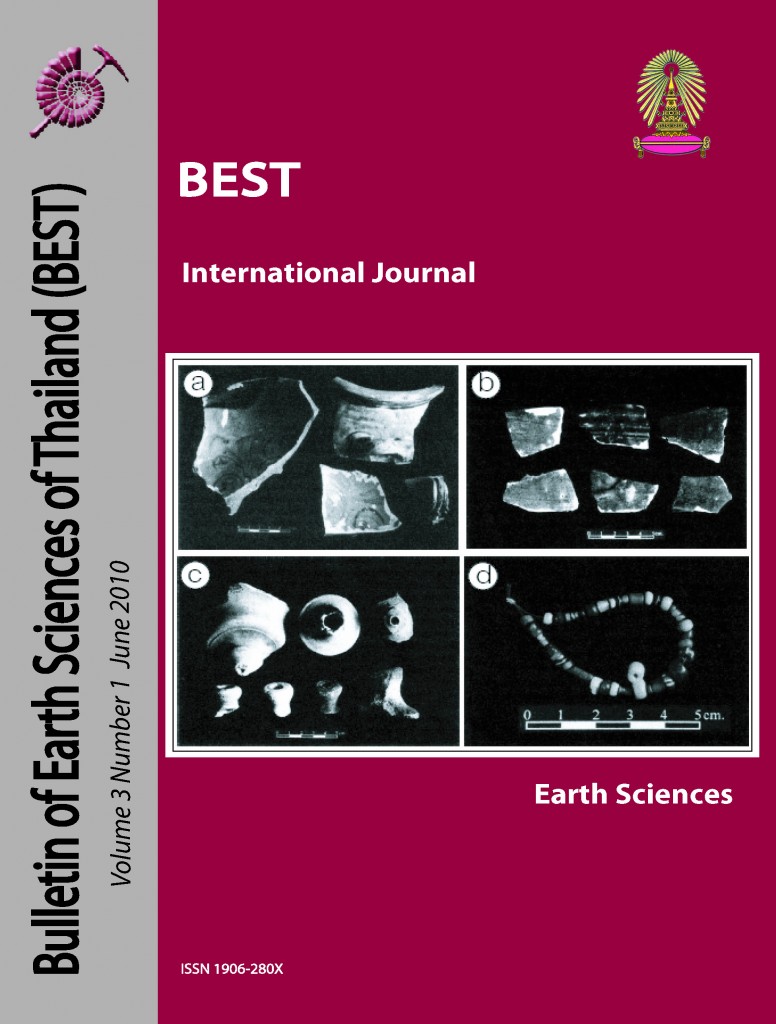Felsic Xenoliths in Corundum-related Basalt at Khao Lun Tom, Bo Phloi District, Kanchanaburi Province, Western Thailand
Main Article Content
Abstract
Felsic xenoliths found within an area of Cenozoic alkali basalt related to corundum deposit in Bo Phloi district, Kanchanaburi province, western Thailand, were collected for this study. Petrography, mineral chemistry and whole-rock geochemistry were carried out and aimed to find relationship with corundum formation. Based on petrographic description, alkali feldspar, plagioclase and quartz are significantly essential minerals whereas accessory minerals are composed of biotite, zircon, apatite and ilmenite. Porphyritic and poikilitic textures are clearly distinguished as primary texture, particularly in feldspar grains; besides, quenched texture and reaction product induced by basaltic magma usually present around edges of these feldspars. Whole-rock geochemistry also yields similar result with slight variation in composition. These xenoliths can be classified, based on petrochemical data, as granite to syenite. Alumina saturations of all xenolith samples are classed as peraluminous series which normative corundum present sometimes in these samples. Essential minerals of these felsic xenoliths have similar chemical compositions. Feldspar compositions, in particular, are equivalent to about 700-800ºC of equilibrated temperature, estimated at a pressure of 5 Kbar, and they seem to have been heated up to over 1000ºC by basaltic magma. In conclusion, these felsic xenoliths appear to have originated in high aluminous igneous provenances in which differentiation processes had been taken place before picking up and transportation to the surface via basaltic eruption. Although, corundum has potential to crystallize within some of these xenoliths, corundum crystal has never been found during this study. However, more samples should be collected for further investigation.
Article Details

This work is licensed under a Creative Commons Attribution-NonCommercial-NoDerivatives 4.0 International License.
Copyright © 2008 Department of Geology, Faculty of Science, Chulalongkorn University. Parts of an article can be photocopied or reproduced without prior written permission from the author(s), but due acknowledgments should be stated or cited accordingly.
References
Barr, S.M., and Macdonald, A.S. 1981. Geochemistry and geochronology of Late Cenozoic basalts of Southeast Asia. Geological Society of America Bulletin, 92(2): 1069-1142.
Charusiri, P., Ampaiwan, T., Hisada, K., Khaowiset, K., Kosuwan, S., and Daorerk, V. 2002. Geotectonic evolution of Thailand: Compilation and new synthesis. Journal Scientific Research Chulalongkorn University (Section T), 1: 69-108.
Coenraads, R.R., Vichit, P., and Sutherland, F.L. 1995. An unusual sapphire-zirconmagnetite xenolith from the Chanthaburi Gem Province, Thailand. Mineralogical Magazine, 59: 465-479.
Cox, K.G., Bell, J.D., and Pankhurst, R.J. 1979. The Interpretation of Igneous Rocks. George, Allen and Unwin, London. Department of Mineral Resources (DMR). 1976. Geological Map scale 1:250.000, Sheet ND 47-7.
Elkins, L.T., and Grove, T.L. 1990. Ternary feldspar experiments and thermodynamic models. American Mineralogist, 75: 544-559.
Guo, J., Griffin, W.L., and O’Reilly, S.Y. 1994. A cobalt-rich spinel inclusion in a sapphire from Bo Ploi, Thailand. Mineralogical Magazine, 58: 247-258.
McCabe, R., Celeya, M., Cole, J., Han, H.C., Ohnstadt, T., Paijitprapaporn, V., and Thitisawan, V. 1988. Extension tectonics: The Neogene opening of the N-S trend basin of central Thailand. Journal of the Geophysical Researches, 93: 11899-11910.
Pisutha-Arnold, V., Wathanakul, P., Intasopa, S., andGriffin, W.L. 1998. Corsilzirspite, a corundum silimanite-zircon-hercynite rock: New evidence on the origin of Kanchanaburi sapphire, Thailand, Proceedinds of the Ninth Regional Congress on Geology, Mineral and Energy Resources of South East Asia GEOSEA 98. Kuala Lumpur, 95-96 (Abstract).
Sutherland, F.L., Hoskin, P.W.O., Fanning, C.M., and Coenraads, R.R. 1998. Models of corundum origin from alkali basaltic terrains: A reappraisal. Contributions to Mineralogy and Petrology, 133: 356-372.
Srithai, B. 2005. Petrography and mineral chemistry of ultramafic xenoliths from Bo Ploi basalt, Kanchanaburi, Thailand. Proceedings of the International Conference on Geology, Geotechnology and MineralResource of Indochina. Bangkok, 358-364.
Sutthirat, C. 2001. Petrogenesis of mantle and crustal xenoliths and xenocrysts in basaltic rocks associated with corundum deposits in Thailand. PhD Thesis (unpublished), Department of Earth Sciences, University of Manchester, UK, 445 pp.
Sutthirat, C. Charusiri, P., Farrar, E. and Clark, A.H. 1994. New 40Ar/39Ar geochronology and characteristic of some Cenozoic basalt in Thailand. Proceedings of the International Symposium on Stratigraphic Correlation of Southeast Asia. Bangkok, 306-321.
Sutthirat, C., Droop, G.T.R., Henderson, C.M.B. and Manning D.A.C. 1999. Petrography and mineral chemistry of xenoliths and xenocrysts in Thai corundum-related basalts: Implications for the upper Mantle and lower crust beneath Thailand. Proceedings of the Symposium on Mineral, Energy, and Water Resources of Thailand. Bangkok, 152-161.
Tapponnier, P., Peltzer, G., LeDain, A.Y., Armijo, R., and Cobbold, P. 1982. Propagating extrusion tectonics in Asia: New insights from simple experiments with plasticine. Geology, 10: 611-616.
Wilson, M. 1989. Igneous Petrogenesis. Unwin Hyman, London.


